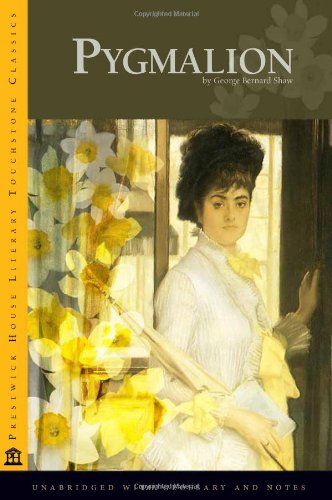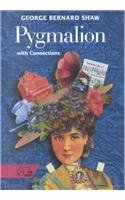-
Arms and the Man
George Bernard Shaw
language (Dover Publications, Nov. 13, 2012)In the opening scene of Arms and the Man, which establishes the play's embattled Balkan setting, young Raina learns of her suitor's heroic exploits in combat. She rhapsodizes that it is "a glorious world for women who can see its glory and men who can act its romance!" Soon, however, such romantic falsifications of love and warfare are brilliantly and at times hilariously unmasked in a comedy that reveals George Bernard Shaw at his best as an acute social observer and witty provocateur. First produced on the London stage in 1894, Arms and the Man continues to be among the most performed of Shaw’s plays around the world. The play is reprinted in its entirety here from an authoritative British edition, and is complete with Shaw's stimulating preface to Volume II of Plays: Pleasant and Unpleasant.
-
Pygmalion - Literary Touchstone Classic
George Bernard Shaw
Paperback (Prestwick House Inc., June 1, 2005)This Prestwick House Literary Touchstone Classic includes a glossary and reader's notes to help the modern reader appreciate Shaw's wit and cynicism. In this delightful romance about the man too self-centered to fall in love and the woman too unsure of herself to want more out of life than the little she already has, George Bernard Shaw shakes the dust off the Cinderella story and tells it as only he can. Eliza Doolittle, the Cockney flower girl who wants to work in a flower shop, and Henry Higgins, the phoneticist who turns her into a princess, are no mythological knight and maiden. Instead, even today, they resound with sharp humor and cutting dialogue. Originally published in 1914, Pygmalion invites readers and audience members to examine the roots of social prejudice and the true value of a human being, while also involving them in the improbable lives of Shaw's one-dimensional, yet endearing characters. From the PublisherPygmalion was originally a play written for the stage by George Bernard Shaw in 1913. It was a typical five-act play: Act I taking place in the street outside of Covent Garden Theater; Act II taking place in the library of Henry Higgins s home on Wimpole Street. Act III takes place in the drawing room of Higgins s mother at her at-home. Act IV returns to Higgins s home, and Act V returns to Mrs. Higgins s drawing room. There are, in all, three sets: the London street, Higgins s library, and Mrs. Higgins s drawing room. The 1913 stage play is the version reproduced in the Prestwick House Literary Touchstone. It is interesting to note that, after theater audiences and critics complained about the ambiguous ending of the 1913 stage play and the apparent lack of a happy ending, Shaw wrote an epilogue, which is included in the Touchstone edition. In this epilogue, Shaw narrates the events of the years following the close of the play. Eliza marries Freddy. He drops the Eynsford from his name and with financial assistance from Colonel Pickering opens a green-grocer shop. Eliza, also with Pickering s help, opens a florist shop next door to Freddy. The couple remains close friends with the Colonel and Higgins, neither of whom ever marry. In 1938, Shaw adapted his stage play for the screen. This film version of Pygmalion starred Leslie Howard as Higgins and Wendy Hiller as Eliza. There are several notable differences between the 1913 stage play and the 1938 screenplay. While the stage play has a decidedly Victorian flavor, the screen play is definitely twentieth-century. Whereas in the stage play, Higgins and Pickering intend to take Eliza to an ambassador s garden party, in the screenplay, they take her to an embassy ball. The movie also presents the scene of Eliza s triumph at the ball, which the play does not. To do so in the play would have required an additional set change, costume changes, and a host of stage extras, all of which Shaw and his producer apparently deemed unnecessary. Probably the most significant difference between the 1913 stage play and the 1938 screen play, however, is the ending. Shaw s epilogue must not have satisfied the public, as, at the end of the 1938 movie, Eliza returns to Higgins. It is the 1938 screenplay that served as the basis for the 1956 stage musical and the 1964 movie musical, My Fair Lady. Again, however, there were significant changes. The visit to Mrs. Higgins s home in Act III becomes a visit to the Ascot Racecourse. The role of Eliza s father and his marriage in Act V are greatly expanded. How Eliza spends the night after the embassy ball is expanded, and so on.
-
Arms and the Man
Bernard Shaw
language (, April 11, 2019)Arms and the Man is a comedy by George Bernard Shaw, whose title comes from the opening words of Virgil's Aeneid, in Latin: Arma virumque cano ("Of arms and the man I sing").The play was first produced on 21 April 1894 at the Avenue Theatre and published in 1898 as part of Shaw's Plays Pleasant volume, which also included Candida, You Never Can Tell, and The Man of Destiny. Arms and the Man was one of Shaw's first commercial successes. He was called onto stage after the curtain, where he received enthusiastic applause. Amidst the cheers, one audience member booed. Shaw replied, in characteristic fashion, "My dear fellow, I quite agree with you, but what are we two against so many?Arms and the Man is a humorous play that shows the futility of war and deals comedically with the hypocrisies of human nature.
-
ANDROCLES AND THE LION
Bernard. Shaw
Hardcover (Penguin Books, 1962., Middlesex, England:, March 15, 1962)None
-
Candida
Bernard Shaw
Paperback (Independently published, Feb. 23, 2019)The play is set in the northeast suburbs of London in the month of October. It tells the story of Candida, the wife of a famous clergyman, the Reverend James Mavor Morell. Morell is a Christian Socialist, popular in the Church of England, but Candida is responsible for much of his success. Candida returns home briefly from a trip to London with Eugene Marchbanks, a young poet who wants to rescue her from what he presumes to be her dull family life.
-
Saint Joan: A chronicle play in six scenes and an epilogue
George Bernard Shaw
Paperback (Dover Publications, Oct. 16, 2019)Hailed by T. S. Eliot as "a dramatic delight," George Bernard Shaw's only tragedy traces the life of the peasant girl who led French troops to victory over the English in the Hundred Years' War. An avid socialist, Shaw regarded his writing as a vehicle for promoting his political and humanitarian views and exposing hypocrisy. With Saint Joan, he reached the height of his fame, and it was this play that led to his Nobel Prize in Literature for 1925. In the six centuries since her martyrdom, Joan of Arc has inspired artists, musicians, and writers. Shaw's heroine is unlike any previous interpretation — not a witch, saint, or madwoman but a pre-feminist icon, possessed of innate intelligence and leadership qualities that challenge the authority of church and state. She is also a real human being, warm and sincere, whose flaws include an obstinacy that leads to her undoing. This edition includes a substantial, informative Preface by the author.
-
Pygmalion: A Romance in Five Acts with Connections
George Bernard Shaw
Hardcover (Holt, Rinehart and Winston, Jan. 5, 2000)Shaw's play in which a professor attempts to transform an unkempt London flower girl into a society belle is accompanied by a biographical sketch of the author and commentaries.
-
Arms and the Man
George Bernard Shaw
eBook (Dover Publications, Nov. 13, 2012)In the opening scene of Arms and the Man, which establishes the play's embattled Balkan setting, young Raina learns of her suitor's heroic exploits in combat. She rhapsodizes that it is "a glorious world for women who can see its glory and men who can act its romance!" Soon, however, such romantic falsifications of love and warfare are brilliantly and at times hilariously unmasked in a comedy that reveals George Bernard Shaw at his best as an acute social observer and witty provocateur. First produced on the London stage in 1894, Arms and the Man continues to be among the most performed of Shaw’s plays around the world. The play is reprinted in its entirety here from an authoritative British edition, and is complete with Shaw's stimulating preface to Volume II of Plays: Pleasant and Unpleasant.
-
SAINT JOAN
Bernard Shaw
Hardcover (Dodd Mead & Company, Sept. 3, 1946)None
-
Cashel Byron's Profession
Bernard Shaw
Paperback (Independently published, Aug. 8, 2019)Although George Bernard Shaw is today best remembered for his work as a playwright, he also penned numerous novels over the course of his creative career. Cashel Byron's Profession explores class issues in a story that follows the blooming love affair between a prizefighter and his upper-class inamorata.
-
Cashel Byron's Profession
Bernard Shaw
Paperback (Independently published, Feb. 23, 2019)Although George Bernard Shaw is today best remembered for his work as a playwright, he also penned numerous novels over the course of his creative career. Cashel Byron's Profession explores class issues in a story that follows the blooming love affair between a prizefighter and his upper-class inamorata.
-
Androcles and the Lion: A Fable Play
Bernard Shaw
Paperback (Forgotten Books, April 19, 2018)Excerpt from Androcles and the Lion: A Fable PlayI say distinctive, because his common humanity and his subjection to time and space (that is, to the Syrian life of his period) involved his belief in many things, true and false, that in no way distinguish him from other Syrians of that time. But such common beliefs do not constitute specific Christianity any more than wearing a beard, work ing in a carpenter's shop, or believing that the earth 1s flat and that the stars could drop on it from heaven like hail stones. Christianity interests practical statesmen now be cause of the doctrines that distinguished Christ from the Jews and the Barabbasques generally, including ourselves.About the PublisherForgotten Books publishes hundreds of thousands of rare and classic books. Find more at www.forgottenbooks.comThis book is a reproduction of an important historical work. Forgotten Books uses state-of-the-art technology to digitally reconstruct the work, preserving the original format whilst repairing imperfections present in the aged copy. In rare cases, an imperfection in the original, such as a blemish or missing page, may be replicated in our edition. We do, however, repair the vast majority of imperfections successfully; any imperfections that remain are intentionally left to preserve the state of such historical works.